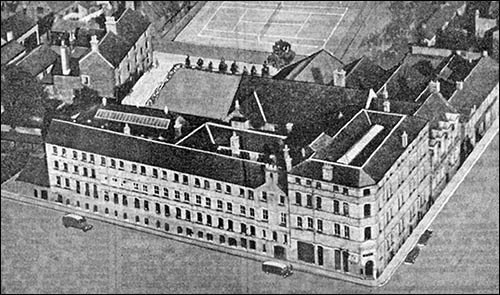|
Wallis and Linnell Ltd grew from the combined talents of two opposites. London businessmen who dress at the “House of Burleigh” owe much to the dreams of a vague and kindly mystic and the dogged foresight of a one-time Manchester warehouseman. These are Wallis and Linnell, the unlikely pair whose fortunes met and crossed in the warm Spring of 1856. They were surely the strangest opposites and yet in some peculiar way each stamped the firm of Wallis and Linnell Ltd. with his own indelible personality.
Frederic Wallis was the senior. He was born in 1833 at Rothwell Lodge, Kettering, and spent his schooldays at the Quaker School of Ackworth, Yorkshire. There were then no holidays and the poor young Frederic spent four years at Ackworth without coming within 200 miles of Kettering. After school he went to Nantwich, Cheshire, where his future was roughly mapped out. He began work in a drapery firm, married his boss’s daughter and then came back to his birthplace seven years later as a fairly prosperous young man of 22. It was then Christmas 1855.
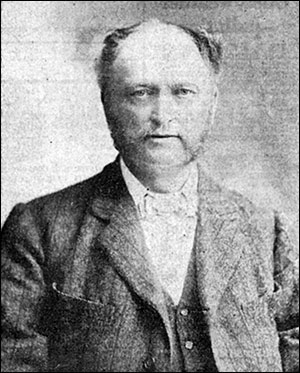 |
|
John Linnell (1836-1916)
|
|
Shortly before this another Northamptonshire man (three years younger than Frederic) was learning that life was a hard marathon. John Linnell came from Burton Latimer, born into a sound farming family who apprenticed him to an equally sound draper, William Toller, in Market Street, Kettering, in 1850. He was then only 13. But William Toller’s ambitions were not wide enough to contain John Linnell – whose lineage was long and loud with names, traditions and learning. He resolved to take his trade seriously and left Kettering for Manchester to get experience in warehouse work. It was harder than he thought. He spent weeks tramping the streets, before he was taken on at warehouse floor level. But he stuck to his ambitions and returned to Kettering shortly after the young Mr. Wallis has started up a clothing factory in School Lane, in partnership with Linnell’s former employer, William Toller.
John now joined Frederic and William in the new firm of Wallis and Co. and, when William left, became partner in 1856. Wallis and Linnell’s had been founded. But in the next forty years it was to seem more like Linnell’s than Wallis’. The one was a powerful, able businessman, eager for change and invention. His partner was kind and vague, with a love for books, children and learning. Frederic Wallis cared far more about his employees being able to read and write than he did about their professional skills.
Long before Wallis died in 1885 at the early age of 52, Linnell’s was the name that really carried weight. It was his energy and foresight that brought the factory from its humble unpretentious beginnings to fame and fortune. He lived on till 1916 in Wilby House, a firm, kindly man, honest, sober and respected. He was liberal in outlook, a follower of Joseph Chamberlain, a man of quiet, steadily held principles. In his later years he insisted on being wheeled to church every Sunday in a bath chair.
But, while he was growing older, what was happening to Wallis and Linnell’s, the firm whose prosperity he had nurtured? It was soon evident that Kettering had not the population to satisfy the need of an expanding business. Automation was growing, but not fast enough. And Kettering, at the time that the firm was started was a modest town with only 4,000 people. Nor did the population increase rapidly enough to keep pace with the factory’s expansion. So, in 1874, the first two colonies were founded at Cottingham and Brigstock. Heating in these new factories (then, quite up-to-date) was by coke stoves on all floors, lighting by oil lamps. Machines were operated by feed and the footsore workers started on a wage of 3s for a 72 hour week! In 1855 another branch began in a quiet corner of Gretton and, a year after that, one at Woodford. But the Regent Street factory did not open production until as late as 1924.
The formative years of Wallis and Linnell Ltd. are not well documented and were not interrupted by a few startling climaxes. Evan a bad fire which destroyed much of the School Lane building failed to block the firm’s growth for long. And adolescence was marked by years of gradual change. Throughout the years there was a steady procession of hand machines leaving the various works and brand new mechanical ones coming in. History and automation were changing the scheme of things. So much so in fact, that the number of employees had gone down, rather than up! In 1906, there were well over 1,000 workers in the five factories. Now there are only 600.
In the 1880’s. Percy Wallis came to join his father and John Linnell, after the traditional Ackworth education and Nantwich training. He was a brilliant economist, a keen young Radical, and a personal friend of most of the early Fabians and members of the I.L.P. He won a great reputation as a generous employer with far-sighted policies and a mind for progress as well as profit. He died in 1945 at the age of 80.
Since 1920, on the other side of the business, responsibilities had shifted to the shoulders of the young Linnells, Jack and Geoffrey. It is they who are now controllers of the firm. They were sons of the original John Linnell (who had died in 1916) and began their careers by service in the first world war and further education at Cambridge. They became directors in 1945.Both lived at Wilby. Jack is single but his brother is married with one son, called by the traditional family name of William. Both Mr. Jack and Geoffrey Linnell have their own planes, are interested in machinery and the future. They seem very suitable members of a family which boasts among its ancestors, a well-known artist. John Linnell (one of whose paintings hangs in Kettering art gallery) was a craftsman who used to carve and decorate Adam fireplaces and whose workmanship now commands high prices at any sale.
The original Linnells were descended from a man called Lunell, who came over with William the Conqueror. Now vans carrying the trade name “The House Of Burleigh” take coats, jackets, trousers to all parts of Britain from the School Lane factory. The export trade is also considerable.
Strangely enough, the premises have never been moved. Unlike many firms, instead of expanding by shifting to new ground Wallis and Linnell’s have done so by continually knocking down and re-building within the same walls. There are no Wallis’ left in the business. Percy Wallis died without leaving any children to inherit his interest. But somehow, among the swing coats, the lofty halls of the present building wrapped around its School Lane corner, there seems to be still preserved something of the mystical warm, kindly, friendly air of the original family man.
|
Below are photographs taken in the Kettering factory in 1969, some years later than the above article.
|
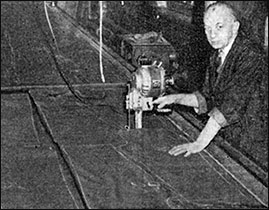 |
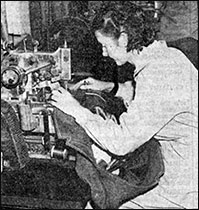 |
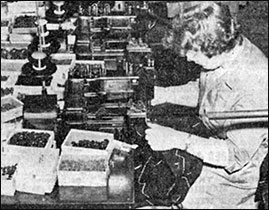 |
|
One man and his trousers.
|
Mrs. Nora Buckby working
at the buttonhole machine.
|
Button stitching machine operated
by Elizabeth Trustlow.
|
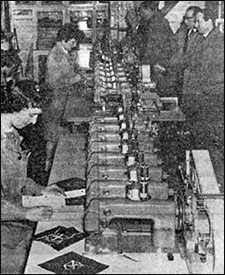 |
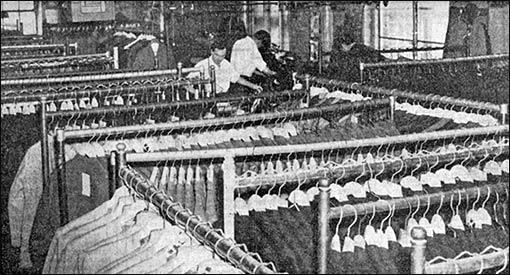 |
|
The "Eight-handed man'"
badge making machine.
|
In the Finishing Room, suits for all shapes and sizes.
Suits for more or less anyone who will pay to be well dressed.
|
|
